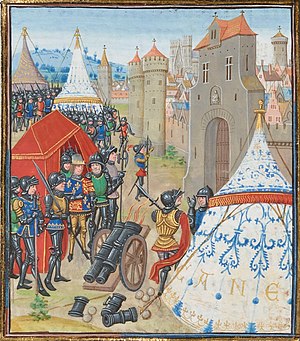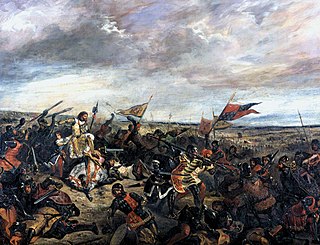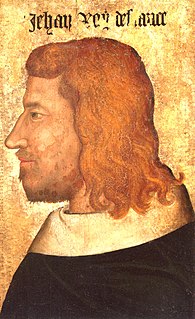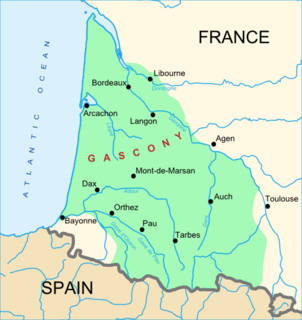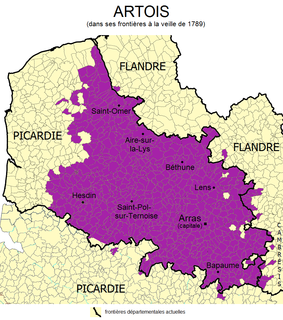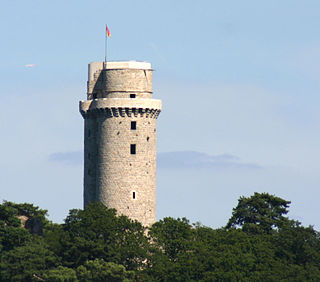
Edward of Woodstock, known to history as the Black Prince, was the eldest son of King Edward III of England, and thus the heir to the English throne. He died before his father and so his son, Richard II, succeeded to the throne instead. Edward nevertheless still earned distinction as one of the most successful English commanders during the Hundred Years' War, being regarded by his contemporaries as a model of chivalry and one of the greatest knights of his age.
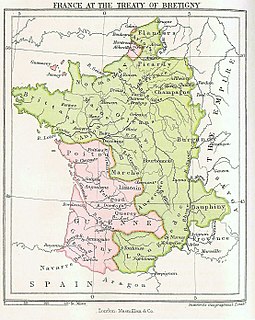
The Treaty of Brétigny was a treaty, drafted on 8 May 1360 and ratified on 24 October 1360, between King Edward III of England and King John II of France. In retrospect it is seen as having marked the end of the first phase of the Hundred Years' War (1337–1453)—as well as the height of English power on the Continent.
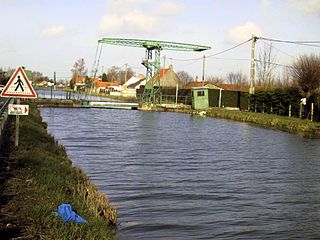
Guînes (Dutch:Wijnen)is a commune in the Pas-de-Calais department in northern France. Historically it was spelt Guisnes.
Ponthieu was one of six feudal counties that eventually merged to become part of the Province of Picardy, in northern France. Its chief town is Abbeville.

Louis I was the second son of John II of France and Bonne of Bohemia. Born at the Château de Vincennes, Louis was the founder of the Angevin branch of the French royal house. His father appointed him Count of Anjou and Count of Maine in 1356, and then raised him to the title Duke of Anjou in 1360 and Duke of Touraine in 1370.

The Edwardian War was the first phase of the Hundred Years' War between France and England. It was named after King Edward III of England, who claimed the French throne in defiance of King Philip VI of France. The dynastic conflict was caused by disputes over the French feudal sovereignty over Aquitaine and the English claims over the French royal title. The Kingdom of England and its allies dominated this phase of the war.
Arnoul d'Audrehem was a Marshal of France, who fought in the Hundred Years' War.
The County of Ponthieu, centered on the mouth of the Somme, became a member of the Norman group of vassal states when Count Guy submitted to William of Normandy after the battle of Mortemer. It eventually formed part of the dowry of Eleanor of Castile and passed to the English crown. Much fought-over in the Hundred Years' War, it eventually passed to the French royal domain, and the title Count of Ponthieu became a courtesy title for the royal family.
The ransom of King John II of France was an incident during the Hundred Years War between France and England. Following the English capture of the French king during the Battle of Poitiers in 1356, John was held for ransom by the English crown. The incident had serious consequences for later events in the Hundred Years War.

The Pale of Calais was a historical region in France that was controlled by the monarchs of England following the Battle of Crécy in 1346 and the subsequent siege. Pale is an archaic English term for "area, jurisdiction". Its capture by the English is the subject of Auguste Rodin's 1889 sculpture The Burghers of Calais. In 1558, the expanding Kingdom of France annexed the Pale of Calais in the aftermath of the Siege of Calais.
The crown lands, crown estate, royal domain or domaine royal of France refers to the lands, fiefs and rights directly possessed by the kings of France. While the term eventually came to refer to a territorial unit, the royal domain originally referred to the network of "castles, villages and estates, forests, towns, religious houses and bishoprics, and the rights of justice, tolls and taxes" effectively held by the king or under his domination. In terms of territory, before the reign of Henry IV, the domaine royal did not encompass the entirety of the territory of the kingdom of France and for much of the Middle Ages significant portions of the kingdom were the direct possessions of other feudal lords.

A free company was an army of mercenaries between the 12th and 14th centuries recruited by private employers during wars. They acted independently of any government, and were thus "free". They regularly made a living by plunder when they were not employed; in France they were the routiers and écorcheurs who operated outside the highly structured law of arms. The term "free company" is most applied to those companies of soldiers which formed after the Peace of Brétigny during the Hundred Years' War and were active mainly in France, but it has been applied to other companies, such as the Catalan Company and companies that operated elsewhere, such as in Italy and the Holy Roman Empire.
The dual monarchy of England and France existed during the latter phase of the Hundred Years' War when Charles VII of France and Henry VI of England disputed the succession to the throne of France. It commenced on 21 October 1422 upon the death of King Charles VI of France, who had signed the Treaty of Troyes which gave the French crown to his son-in-law Henry V of England and Henry's heirs. It excluded King Charles's son, the Dauphin Charles, who by right of primogeniture was the heir to the Kingdom of France. Although the Treaty was ratified by the Estates-General of France, the act was a contravention of the French law of succession which decreed that the French crown could not be alienated. Henry VI, son of Henry V, became king of both England and France and was recognized only by the English and Burgundians until 1435 as King Henry II of France. He was crowned King of France on 16 December 1431.

Black Monday took place on Easter Monday (1360) during the Hundred Years' War (1337–60), when a freak hail storm struck and killed an estimated 1,000 English soldiers. The storm was so devastating that it caused more English casualties than any of the previous battles of the war.
Sir Willian Felton and English knight and seneschal of Poitou. Took part in Battle of Halidon Hill, 1333 and fought at Crecy in 1346. He was appointed lord justice of all the king's lands in Scotland in 1348, He fought at battle of Poitiers in 1356. He was appointed seneschal of Poitou in 1360. He accompanied Black Prince on the Spanish campaign in 1367 and was called Felleton Guilliam qui ot cœur de lyon by Chandos Herald. He was killed at the battle of Aríñez a skirmish fought by the vanguard of the Black Prince's army.

Sir Thomas Felton was an English knight. He fought at the Battle of Crecy in 1346, and the Capture of Calais in 1347. He was also at the Battle of Poitiers in 1356. He was a signatory to treaty of Bretigny in 1360. In 1362 he was appointed seneschal of Aquitaine. He accompanied the Black Prince on his Spanish campaign. He was taken prisoner by Henry of Trastamare's forces in 1367. In 1372 he was appointed joint-governor of Aquitaine and seneschal of Bordeaux. He caused Guillaume de Pommiers and his secretary to be beheaded for treason in 1377 and was made a Knight of the Garter in 1381.
The Truce of Calais was a truce agreed to by King Edward III of England and King Philip VI of France on 28 September 1347, that was mediated by Pope Clement VI. Originally agreed to last for nine months, it was repeatedly renewed until 1355.
